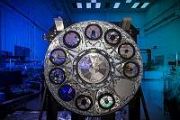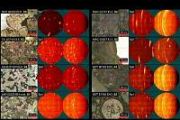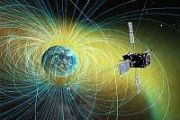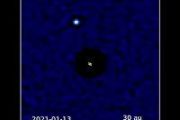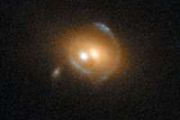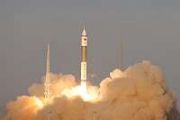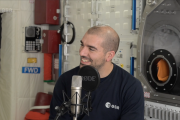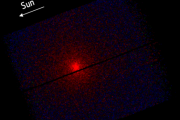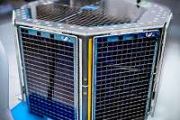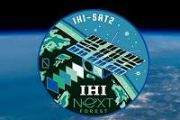
Copernical Team
ESA pinpoints 3I/ATLAS's path with data from Mars
 Since comet 3I/ATLAS, the third known interstellar object, was discovered on 1 July 2025, astronomers worldwide have worked to predict its trajectory. ESA has now improved the comet's predicted location by a factor of 10, thanks to the innovative use of observation data from our ExoMars Trace Gas Orbiter (TGO) spacecraft orbiting Mars.
By being able to use Mars-based data for an unusual ob
Since comet 3I/ATLAS, the third known interstellar object, was discovered on 1 July 2025, astronomers worldwide have worked to predict its trajectory. ESA has now improved the comet's predicted location by a factor of 10, thanks to the innovative use of observation data from our ExoMars Trace Gas Orbiter (TGO) spacecraft orbiting Mars.
By being able to use Mars-based data for an unusual ob Image: A robotic helping hand at the ISS
This request seems a bit unusual, so we need to confirm that you're human. Please press and hold the button until it turns completely green. Thank you for your cooperation!
Press and hold the button
If you believe this is an error, please contact our support team.
185.132.36.159 : 8809a82d-5d34-44b5-a312-996ef495
Two arrangements mark a new step for Ariane 6 and Vega-C exploitation

Sentinel-6B rolls out to the launch pad
 Image:
Sentinel-6B rolls out to the launch pad
Image:
Sentinel-6B rolls out to the launch pad Week in images: 10-14 November 2025

Week in images: 10-14 November 2025
Discover our week through the lens
Twin Mars orbiters launched on New Glenn rocket to study Martian atmosphere
This request seems a bit unusual, so we need to confirm that you're human. Please press and hold the button until it turns completely green. Thank you for your cooperation!
Press and hold the button
If you believe this is an error, please contact our support team.
185.132.36.159 : fae26cdd-8304-4d7d-8877-70102c9a
Chinese astronauts return from space station after delay blamed on space debris damage
This request seems a bit unusual, so we need to confirm that you're human. Please press and hold the button until it turns completely green. Thank you for your cooperation!
Press and hold the button
If you believe this is an error, please contact our support team.
185.132.36.159 : c03f9a40-3d33-4c06-9431-65c18786
CSES satellite tracks shifting South Atlantic anomaly and impact on solar cycle twenty five
 The South Atlantic anomaly represents the region of Earth's radiation belts with the highest particle concentrations and weakest geomagnetic shielding. This area poses risks to the electronics aboard low-Earth orbit satellites and to the health of astronauts.
Researchers from the Institute of High Energy Physics of the Chinese Academy of Sciences, together with the National Institute of Na
The South Atlantic anomaly represents the region of Earth's radiation belts with the highest particle concentrations and weakest geomagnetic shielding. This area poses risks to the electronics aboard low-Earth orbit satellites and to the health of astronauts.
Researchers from the Institute of High Energy Physics of the Chinese Academy of Sciences, together with the National Institute of Na Brazil gears up to harness ESA's Biomass data
 As the COP30 climate conference gets underway in Brazil, the world's attention is once again drawn to the plight of the Amazon - the planet's largest and most vital rainforest. With the European Space Agency's Earth Explorer Biomass satellite now in orbit, ESA is helping Brazil prepare to transform this new mission's groundbreaking data into actionable knowledge for protecting the rainforest and
As the COP30 climate conference gets underway in Brazil, the world's attention is once again drawn to the plight of the Amazon - the planet's largest and most vital rainforest. With the European Space Agency's Earth Explorer Biomass satellite now in orbit, ESA is helping Brazil prepare to transform this new mission's groundbreaking data into actionable knowledge for protecting the rainforest and AI enables tailored education for medical students at scale
 Researchers at Dartmouth have demonstrated that artificial intelligence platforms can provide individualized academic support for large student populations. The study tracked 190 medical students who used an AI teaching assistant called NeuroBot TA in a Neuroscience and Neurology course. NeuroBot TA employs retrieval-augmented generation, anchoring answers to curated course materials and reducin
Researchers at Dartmouth have demonstrated that artificial intelligence platforms can provide individualized academic support for large student populations. The study tracked 190 medical students who used an AI teaching assistant called NeuroBot TA in a Neuroscience and Neurology course. NeuroBot TA employs retrieval-augmented generation, anchoring answers to curated course materials and reducin 






